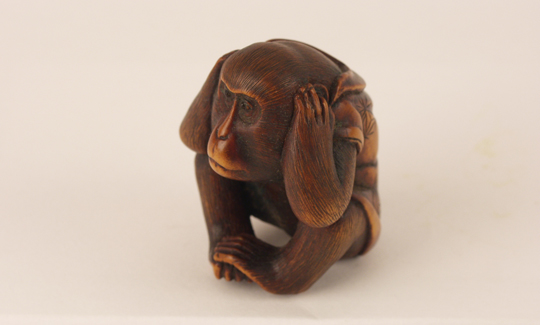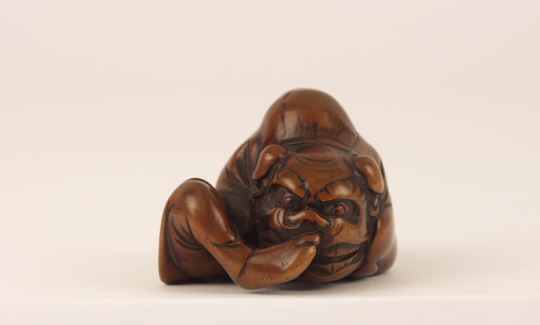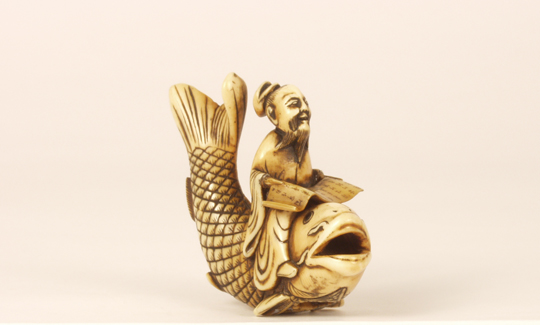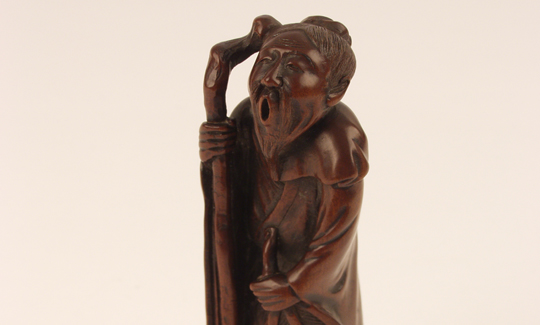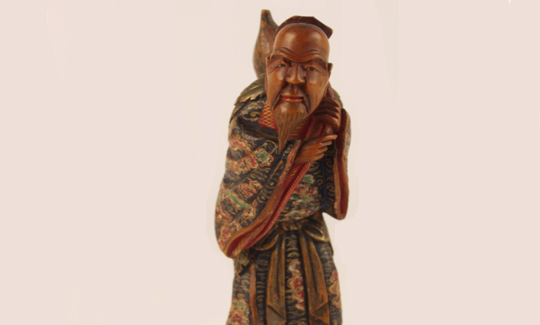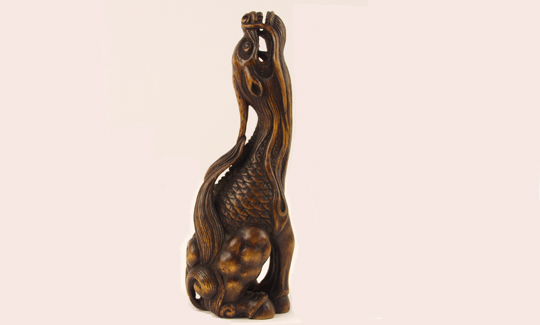The netsuke was originally a decorated accessory on a cord which attached various implements to clothing. It fulfilled an important function as the kimono, the traditional Japanese robe, had no pockets. Instead it was fastened by means of a broad sash tied around the hips on which various receptacles –“sagemono” (“hanging things”) were carried on a cord threaded under the sash (obi). These implements included such items as inrô boxes for seals and medicaments, tobacco pouches, purses, and cases for writing materials. The netsuke, attached to the other end of the cord, rested on the sash. Its original purpose was to prevent the containers from slipping off the cord.
Netsuke (ne - root; tsuke - to fasten), as is evident from the meaning, was originally a very simple object, a piece of root, bamboo, or bone, with two holes for fastening the cord. It very quickly became an object of artistic interest, a small artifact decorated with motifs taken from Japanese folklore and religion.
Netsuke were used by men of all ranks of society as of the sixteenth century, but their greatest proliferation was during the Edo Era (1600-1868). After the Meiji Restoration in 1868, as western-style clothing began to be adopted, the netsuke went out of fashion with the wallets and purses they held in place. These artifacts, which were originally created for everyday use, became an art form and collectors’ items the instant they stopped being a craft. Today there are very few artists creating netsuke.
Netsuke are made of various materials – different kinds of wood such as Japanese boxwood, cedar, cherry, plum and others. Ivory was also used and the tusks of other animals - hippopotamus, boar, whalebone. There are statuettes made of horn, bamboo, bone, semi-precious stones, tortoiseshell and metal. Some of the materials used were thought to have medicinal properties. The jawbone of a specific type of whale would reduce fever, it was believed, and so too deer-horn would cure adder-bite. On these netsuke, one surface was left undecorated, so that it could be scraped and the medicine infused from these scrapings. Artists selected the material according to availability in the area in which they lived, its adaptability as a container, its weight and durability. Netsuke were made by different techniques: paring, relief, carving, engraving, filigree, casting, metal-stamping, lacquer, ceramic, inlay, and paint. Making them was considered a masculine craft, and it took thirty to sixty days of work to create one netsuke.
The first netsuke artists created religious representations, so that most of the subjects were linked to tradition and beliefs - deities, legendary figures and human beings who had been deified, demons and spirits. To these were added real and imaginary creatures, animate and inanimate forms connected with folklore. Accordingly, it is quite difficult to classify the motifs of the netsuke. The eggplant which appears so often is also a symbol connected with the Buddhist Bon Festival (Remembrance Day). On this day an eggplant is placed on the shelf used as the altar of souls. The mouse is one of twelve Sino-Japanese luck signs, and belongs to Daikoku, one of the seven gods of good fortune. Two mice signify the complementary forces of yin and yang. Since all of nature is sacred, according to the Japanese Shintô belief, and the gods are interconnected with the real world, the attitude towards the netsuke is not simply one of aesthetic appreciation. Rather, it expresses deeply felt spiritual and cultural values.
Netsuke demonstrate the Japanese concept of embellishing everyday objects and transforming them into artistic works. The high technical quality and accuracy of detail of the Japanese artists did not interfere with individual expression and interpretation of legends or of folk and religious traditions. The motifs of the netsuke provide us with an endless source for comprehension of the customs, symbols, fables and concepts of the period.
Types of netsuke in the Exhibition:
Katabori (carving in the round) - The most common is a three-dimensional sculpture. Among its motifs are religious images, animals, imaginary creatures and plants. The katabori is made of wood, ivory, horn, bone, ceramic, porcelain or lacquer-ware.
Manju - The same name as the Japanese rice-cake, it is round, oval or square and flat with a design on it. Manju are made of ivory, lacquer-ware, metal or porcelain. They are made either in one or two pieces.
Kagamibuta (mirror lid) - is a form of manju. The kagamibuta has one concave section, made of ivory, horn, or wood, with a metal cover like a Japanese mirror. The metalworkers decorated the lid with engraving or with inlays of precious metals.
Ryûsa - named for the artist who created it in the 18th century, is also a type of hollow manju. The ryusa is either carved or made out of filigree and hence is very light in weight.
Sashi - elongated netsuke statuettes, made out of lengths of bone, bamboo, wood or ivory.
Netsuke masks - were generally made as a hobby by the artists who created masks for the traditional Nô Theatre of Japan. Highly detailed masks were carved from wood, as were the originals, and were sometimes coated with lacquer.
Dr. Ilana Singer Blaine, Chief Curator
Tikotin Museum of Japanese Art
Free entree to the exhibitions for children and youth up to the age of 18 during Sukkot (6-11.10.17)
Entrance for children up to the age of 16 is conditional upon an adult accompanied by a fee! * Children over the age of 16 can enter without an adult * The offer is not valid for groups or student visits * Excludes events and workshops

